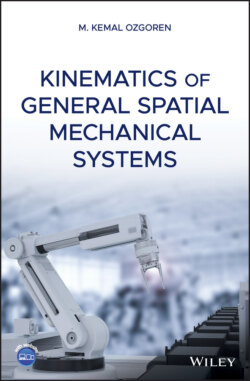Читать книгу Kinematics of General Spatial Mechanical Systems - M. Kemal Ozgoren - Страница 68
3.8.4 Remark 3.4
ОглавлениеIn an Euler angle sequence, irrespective of whether it is an IFB i‐j‐k or an RFB i‐j‐k sequence, the indices must be such that j ≠ i and j ≠ k in order to keep the angles φ1, φ2, and φ3 independent. Otherwise, these angles can no longer be independent.
For example, if j = i, the three‐factor expression in Eq. (3.102) degenerates into the following two‐factor expression.
(3.103)
Similarly, if j = k, the three‐factor expression in Eq. (3.102) degenerates this time into the following two‐factor expression.
(3.104)
Equation (3.103) shows that has a missing parameter and it is expressed in terms of only two independent parameters, which are φ4 and φ3. This is because φ1 and φ2 happen to be indistinguishable and indefinite rotation angles about the same axis with a combined effect that can actually be achieved by a single rotation angle φ4. In other words, φ1 and φ2 happen to be dependent on each other because they complement each other to the effective rotation angle φ4, that is, φ1 + φ2 = φ4.
Equation (3.104) shows a similar situation with a different effective rotation angle φ5. In this case, φ2 and φ3 happen to be indistinguishable and indefinite rotation angles, which are dependent because they complement each other to the effective rotation angle φ5, that is, φ2 + φ3 = φ5.
On the other hand, it is possible to have k = i ≠ j. Based on this possibility, an Euler angle sequence is called symmetric if k = i and asymmetric if k ≠ i. For example, the RFB 1‐2‐3 sequence is asymmetric, whereas the RFB 3‐1‐3 sequence is symmetric.
